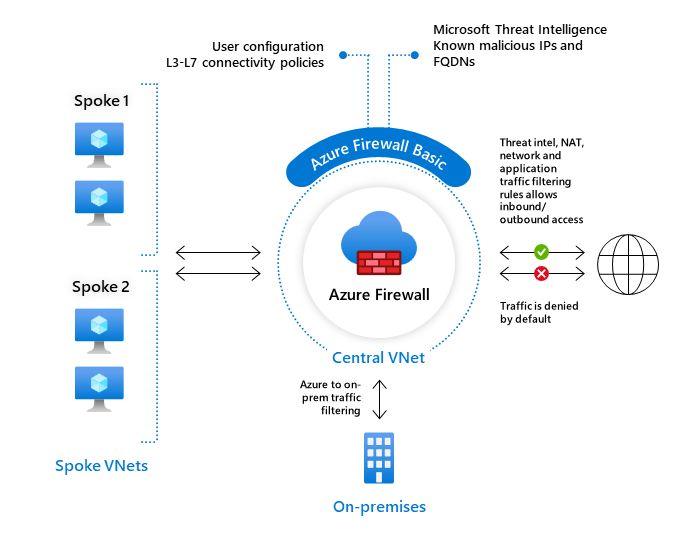Azure Firewall Basic features
Azure Firewall Basic is a managed, cloud-based network security service that protects your Azure Virtual Network resources.

Azure Firewall Basic includes the following features:
- Built-in high availability
- Availability Zones
- Application FQDN filtering rules
- Network traffic filtering rules
- FQDN tags
- Service tags
- Threat intelligence in alert mode
- Outbound SNAT support
- Inbound DNAT support
- Multiple public IP addresses
- Azure Monitor logging
- Certifications
To compare Azure Firewall features for all Firewall versions, see Choose the right Azure Firewall version to meet your needs.
Built-in high availability
High availability is built in, so no extra load balancers are required and there's nothing you need to configure.
Availability Zones
Azure Firewall can be configured during deployment to span multiple Availability Zones for increased availability. You can also associate Azure Firewall to a specific zone for proximity reasons. For more information on availability, see the Azure Firewall Service Level Agreement (SLA).
There's no extra cost for a firewall deployed in more than one Availability Zone.
Azure Firewall Availability Zones are available in regions that support availability zones. For more information, see Regions with availability zone support.
Application FQDN filtering rules
You can limit outbound HTTP/S traffic or Azure SQL traffic to a specified list of fully qualified domain names (FQDN) including wild cards. This feature doesn't require Transport Layer Security (TLS) termination.
The following video shows how to create an application rule:
Network traffic filtering rules
You can centrally create allow or deny network filtering rules by source and destination IP address, port, and protocol. Azure Firewall is fully stateful, so it can distinguish legitimate packets for different types of connections. Rules are enforced and logged across multiple subscriptions and virtual networks.
Azure Firewall supports stateful filtering of Layer 3 and Layer 4 network protocols. Layer 3 IP protocols can be filtered by selecting Any protocol in the Network rule and select the wild-card * for the port.
FQDN tags
FQDN tags make it easy for you to allow well-known Azure service network traffic through your firewall. For example, say you want to allow Windows Update network traffic through your firewall. You create an application rule and include the Windows Update tag. Now network traffic from Windows Update can flow through your firewall.
Service tags
A service tag represents a group of IP address prefixes to help minimize complexity for security rule creation. You can't create your own service tag, nor specify which IP addresses are included within a tag. Microsoft manages the address prefixes encompassed by the service tag, and automatically updates the service tag as addresses change.
Threat intelligence
Threat intelligence-based filtering can be enabled for your firewall to alert traffic from/to known malicious IP addresses and domains. The IP addresses and domains are sourced from the Microsoft Threat Intelligence feed.
Outbound SNAT support
All outbound virtual network traffic IP addresses are translated to the Azure Firewall public IP (Source Network Address Translation). You can identify and allow traffic originating from your virtual network to remote Internet destinations. Azure Firewall doesn't SNAT when the destination IP is a private IP range per IANA RFC 1918.
If your organization uses a public IP address range for private networks, Azure Firewall will SNAT the traffic to one of the firewall private IP addresses in AzureFirewallSubnet. You can configure Azure Firewall to not SNAT your public IP address range. For more information, see Azure Firewall SNAT private IP address ranges.
You can monitor SNAT port utilization in Azure Firewall metrics. Learn more and see our recommendation on SNAT port utilization in our firewall logs and metrics documentation.
For more detailed information about Azure Firewall NAT behaviors, see Azure Firewall NAT Behaviors.
Inbound DNAT support
Inbound Internet network traffic to your firewall public IP address is translated (Destination Network Address Translation) and filtered to the private IP addresses on your virtual networks.
Multiple public IP addresses
You can associate multiple public IP addresses with your firewall.
Multiple public IP addresses enable the following scenarios:
- DNAT - You can translate multiple standard port instances to your backend servers. For example, if you have two public IP addresses, you can translate TCP port 3389 (RDP) for both IP addresses.
- SNAT - More ports are available for outbound SNAT connections, reducing the potential for SNAT port exhaustion. At this time, Azure Firewall randomly selects the source public IP address to use for a connection. If you have any downstream filtering on your network, you need to allow all public IP addresses associated with your firewall. Consider using a public IP address prefix to simplify this configuration.
Azure Monitor logging
All events are integrated with Azure Monitor, allowing you to archive logs to a storage account, stream events to your event hub, or send them to Azure Monitor logs. For Azure Monitor log samples, see Azure Monitor logs for Azure Firewall.
For more information, see Tutorial: Monitor Azure Firewall logs and metrics.
Azure Firewall Workbook provides a flexible canvas for Azure Firewall data analysis. You can use it to create rich visual reports within the Azure portal. For more information, see Monitor logs using Azure Firewall Workbook.
Certifications
Azure Firewall is Payment Card Industry (PCI), Service Organization Controls (SOC), and International Organization for Standardization (ISO) compliant. For more information, see Azure Firewall compliance certifications.